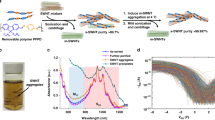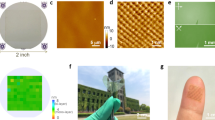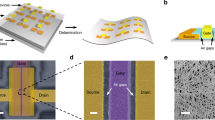Abstract
Integrated circuits that can be interfaced with biological systems could expand the function of electronic devices, providing, for example, advanced forms of monitoring, diagnosis and therapy in clinical applications. However, limitations in the performance of electronic devices on flexible or biodegradable substrates constrain the complexity and power dissipation of such devices. Here, we report carbon nanotube-based thin-film transistors and integrated circuits that can be transferred to arbitrary surfaces. We show that this wafer-scale platform can be transferred to biodegradable polymers, plant leaves and a person's wrist, and demonstrate the operation of the transferred devices and circuits on a curved plant leaf. Our nanotube thin-film transistors on biodegradable flexible substrates have ultralow power consumption with an off-state current as low as 0.1 pA μm−1, a subthreshold swing of 62 mV dec−1, and a static power consumption of 2.5 × 10−13 W in an inverter. The thin-film transistors also exhibit highly uniform performance with an 80 mV standard deviation in the threshold voltages. Furthermore, we constructed a full adder integrated circuit, with rail-to-rail outputs and a read-only memory, on a flexible substrate that can be driven by a small single supply voltage of 2 V.
This is a preview of subscription content, access via your institution
Access options
Access Nature and 54 other Nature Portfolio journals
Get Nature+, our best-value online-access subscription
$29.99 / 30 days
cancel any time
Subscribe to this journal
Receive 12 digital issues and online access to articles
$119.00 per year
only $9.92 per issue
Buy this article
- Purchase on Springer Link
- Instant access to full article PDF
Prices may be subject to local taxes which are calculated during checkout






Similar content being viewed by others
References
Schwartz, G. et al. Flexible polymer transistors with high pressure sensitivity for application in electronic skin and health monitoring. Nat. Commun. 4, 1859 (2013).
Fang, H. et al. Capacitively coupled arrays of multiplexed flexible silicon transistors for long-term cardiac electrophysiology. Nat. Biomed. Eng. 1, 0038 (2017).
Reeder, J. et al. Mechanically adaptive organic transistors for implantable electronics. Adv. Mater. 26, 4967–4973 (2014).
Dagdeviren, C. et al. Conformal piezoelectric systems for clinical and experimental characterization of soft tissue biomechanics. Nat. Mater. 14, 728–736 (2015).
Webb, R. et al. Ultrathin conformal devices for precise and continuous thermal characterization of human skin. Nat. Mater. 12, 938–944 (2013).
Kang, S. et al. Bioresorbable silicon electronic sensors for the brain. Nature 530, 71–76 (2016).
Lee, H. et al. A graphene-based electrochemical device with thermoresponsive microneedles for diabetes monitoring and therapy. Nat. Nanotech. 11, 566–572 (2016).
Kim, J. et al. Stretchable silicon nanoribbon electronics for skin prosthesis. Nat. Commun. 5, 5747 (2014).
Kim, D. et al. Epidermal electronics. Science 333, 838–843 (2011).
Kim, D. et al. Dissolvable films of silk fibroin for ultrathin conformal bio-integrated electronics. Nat. Mater. 9, 511–517 (2010).
Yu, K. et al. Bioresorbable silicon electronics for transient spatiotemporal mapping of electrical activity from the cerebral cortex. Nat. Mater. 15, 782–791 (2016).
Kim, S. et al. Stretchable and transparent biointerface using cell-sheet-graphene hybrid for electrophysiology and therapy of skeletal muscle. Adv. Funct. Mater. 26, 3207–3217 (2016).
Viventi, J. et al. Flexible, foldable, actively multiplexed, high-density electrode array for mapping brain activity in vivo. Nat. Neurosci. 14, 1599–1605 (2011).
Lee, S. et al. A strain-absorbing design for tissue–machine interfaces using a tunable adhesive gel. Nat. Commun. 5, 5898 (2014).
Park, S. et al. Soft, stretchable, fully implantable miniaturized optoelectronic systems for wireless optogenetics. Nat. Biotechnol. 33, 1280–1286 (2015).
Hwang, S. et al. Materials and fabrication processes for transient and bioresorbable high-performance electronics. Adv. Funct. Mater. 23, 4087–4093 (2013).
Wang, C., Zhang, J. & Zhou, C. Macroelectronic integrated circuits using high-performance separated carbon nanotube thin-film transistors. ACS Nano 4, 7123–7132 (2010).
Kang, S. et al. High-performance electronics using dense, perfectly aligned arrays of single-walled carbon nanotubes. Nat. Nanotech. 2, 230–236 (2007).
Wang, C. et al. Extremely bendable, high-performance integrated circuits using semiconducting carbon nanotube networks for digital, analog, and radio-frequency applications. Nano Lett. 12, 1527–1533 (2012).
Chen, Z. et al. An integrated logic circuit assembled on a single carbon nanotube. Science 311, 1735–1735 (2006).
Sun, D. et al. Mouldable all-carbon integrated circuits. Nat. Commun. 4, 2302 (2013).
Chen, H., Cao, Y., Zhang, J. & Zhou, C. Large-scale complementary macroelectronics using hybrid integration of carbon nanotubes and IGZO thin-film transistors. Nat. Commun. 5, 4097 (2014).
Sun, D. et al. Flexible high-performance carbon nanotube integrated circuits. Nat. Nanotech. 6, 156–161 (2011).
Ding, L. et al. CMOS-based carbon nanotube pass-transistor logic integrated circuits. Nat. Commun. 3, 677 (2012).
Chen, B. et al. Highly uniform carbon nanotube field-effect transistors and medium scale integrated circuits. Nano Lett. 16, 5120–5128 (2016).
Yang, Y., Ding, L., Han, J., Zhang, Z. & Peng, L. High-performance complementary transistors and medium-scale integrated circuits based on carbon nanotube thin films. ACS Nano 11, 4124–4132 (2017).
Shulaker, M. et al. Carbon nanotube computer. Nature 501, 526–530 (2013).
Franklin, A. et al. Variability in carbon nanotube transistors: improving device-to-device consistency. ACS Nano 6, 1109–1115 (2012).
Lee, C., Kim, D. & Zheng, X. Fabrication of nanowire electronics on nonconventional substrates by water-assisted transfer printing method. Nano Lett. 11, 3435–3439 (2011).
Li, X. et al. Transfer of large-area graphene films for high-performance transparent conductive electrodes. Nano Lett. 9, 4359–4363 (2009).
Hwang, S. et al. High-performance biodegradable/transient electronics on biodegradable polymers. Adv. Mater. 26, 3905–3911 (2014).
Publications of International Technology Roadmap for Semiconductors (ITRS, 2013); http://www.itrs2.net
Cao, Q. et al. Medium-scale carbon nanotube thin-film integrated circuits on flexible plastic substrates. Nature 454, 495–500 (2008).
Cao, Q., Xia, M., Shim, M. & Rogers, J. Bilayer organic–inorganic gate dielectrics for high-performance, low-voltage, single-walled carbon nanotube thin-film transistors, complementary logic gates, and p–n diodes on plastic substrates. Adv. Funct. Mater. 16, 2355–2362 (2006).
Yu, W. et al. Small hysteresis nanocarbon-based integrated circuits on flexible and transparent plastic substrate. Nano Lett. 11, 1344–1350 (2011).
Chae, S. et al. Transferred wrinkled Al2O3 for highly stretchable and transparent graphene–carbon nanotube transistors. Nat. Mater. 12, 403–409 (2013).
Ha, M. et al. Printed, sub-3 V digital circuits on plastic from aqueous carbon nanotube Inks. ACS Nano 4, 4388–4395 (2010).
Geier, M. et al. Subnanowatt carbon nanotube complementary logic enabled by threshold voltage control. Nano Lett. 13, 4810–4814 (2013).
Sangwan, V. et al. Fundamental performance limits of carbon nanotube thin-film transistors achieved using hybrid molecular dielectrics. ACS Nano 6, 7480–7488 (2012).
Choi, S. et al. Short-channel transistors constructed with solution-processed carbon nanotubes. ACS Nano 7, 798–803 (2013).
Kim, S., Kim, S., Park, J., Ju, S. & Mohammadi, S. Fully transparent pixel circuits driven by random network carbon nanotube transistor circuitry. ACS Nano 4, 2994–2998 (2010).
Lin, Y., Appenzeller, J. & Avouris, P. Ambipolar-to-unipolar conversion of carbon nanotube transistors by gate structure engineering. Nano Lett. 4, 947–950 (2004).
Qiu, C. et al. Carbon nanotube feedback-gate field-effect transistor: suppressing current leakage and increasing on/off ratio. ACS Nano 9, 969–977 (2015).
Zhao, Y. et al. Three-dimensional flexible complementary metal–oxide–semiconductor logic circuits based on two-layer stacks of single-walled carbon nanotube networks. ACS Nano 10, 2193–2202 (2016).
Ha, M. et al. Aerosol jet printed, low voltage, electrolyte gated carbon nanotube ring oscillators with sub-5 μs stage delays. Nano Lett. 13, 954–960 (2013).
Honda, W., Arie, T., Akita, S. & Takei, K. Bendable CMOS digital and analog circuits monolithically integrated with a temperature sensor. Adv. Mater. Tech. 1, 1600058 (2016).
Acknowledgements
This work was supported by the National Natural Science Foundation of China (grants nos. 61571016 and 61621061), the National Key Research & Development Program (grant no. 2016YFA0201901) and the ‘Thousand Talents’ Program for pioneer researchers.
Author information
Authors and Affiliations
Contributions
L.X. and Y.F.H. conceived the experiments. L.X. fabricated the devices, performed the electrical measurements, and analysed and interpreted the data with input from Y.F.H., H.Z., D.L.Z., Z.Y.Z. and L.-M.P. G.D.D., J.H. and X.L.L. prepared the CNT solutions and thin films. The manuscript was written with contributions from all authors, and all authors approved the final version of the manuscript.
Corresponding author
Ethics declarations
Competing interests
The authors declare no competing interests.
Additional information
Publisher's note: Springer Nature remains neutral with regard to jurisdictional claims in published maps and institutional affiliations.
Supplementary information
Supplementary Information
Supplementary Note 1, Supplementary Figures 1–13 and Supplementary Table 1.
Rights and permissions
About this article
Cite this article
Xiang, L., Zhang, H., Dong, G. et al. Low-power carbon nanotube-based integrated circuits that can be transferred to biological surfaces. Nat Electron 1, 237–245 (2018). https://doi.org/10.1038/s41928-018-0056-6
Received:
Accepted:
Published:
Issue Date:
DOI: https://doi.org/10.1038/s41928-018-0056-6
This article is cited by
-
Low power flexible monolayer MoS2 integrated circuits
Nature Communications (2023)
-
Circular polarization-resolved ultraviolet photonic artificial synapse based on chiral perovskite
Nature Communications (2023)
-
Soft Electronics for Health Monitoring Assisted by Machine Learning
Nano-Micro Letters (2023)
-
Intrinsically flexible all-carbon-nanotube electronics enabled by a hybrid organic–inorganic gate dielectric
npj Flexible Electronics (2022)
-
An application-specific image processing array based on WSe2 transistors with electrically switchable logic functions
Nature Communications (2022)



